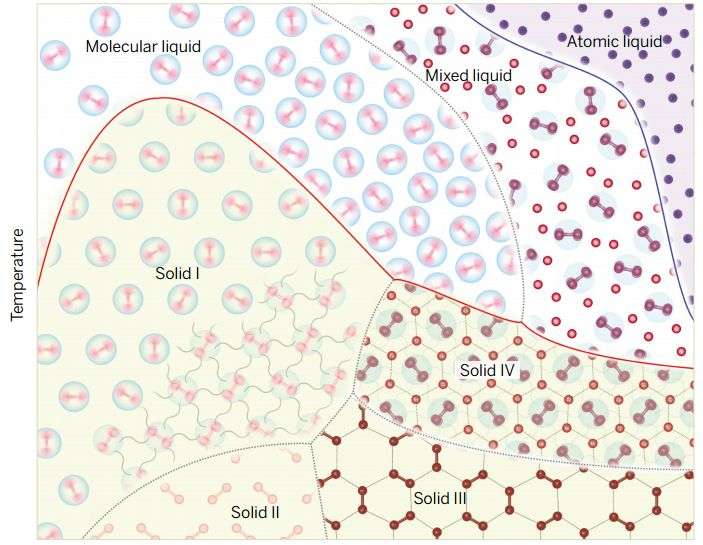June 26, 2015 report
Researchers successfully transform liquid deuterium into a metal

(Phys.org)—A team of researchers working at Sandia National Labs working with another team from the University of Rostock in Germany, has succeeded in squeezing liquid deuterium into becoming what appeared to be a metal. In their paper published in the journal Science, the team describes their new technique which has brought researchers closer to the ultimate goal of creating solid metallic hydrogen.
Back in 1935, a pair of researchers, Hillard Bell Huntington and Eugene Wigner first showed via theory that it should be possible to create solid metallic hydrogen—all that was needed was sufficient pressure. Since that time, various teams have attempted to prove that theory correct, but to date, none have been successful. In this new effort, the research team has developed a new way to add pressure that does not cause other problems. Other than pride, the only real benefit of pursuing the objective is the information that can be gleaned from such efforts, information that might prove useful in studying other planets, for example—it could shed light on the forces necessary to produce observed phenomenon.
Up till now, the technique used to pressurize hydrogen, has been based on squeezing samples of it between two diamond tips—such experiments have shown that it is possible to get compounds rich in hydrogen to become metal-like.
In this new effort, the researchers noted that using the dual diamond tip approach was unlikely to result in achieving the ultimate goal due to the problem of sample materials becoming too reactive. They chose to go another route, making use of the massive Sandia Z machine—it is capable of creating magnetic fields up to 20 mega gauss—they first pressurized a sample of liquid deuterium (a hydrogen isotope) then caused a jolt of current from the Z machine to move through an electrode, which in turn hit the front of the container holding the deuterium—that caused a shockwave to move through the sample, condensing it further. As the material was condensed, the researchers measured how well the sample reflected light, a common means for identifying a metal. As the sample was condensed, it moved from a transparent state, to one that was reflective. This, the team claims, shows that the material clearly moved from an insulator to a metal.
The results by this new team are the closest yet to creating solid metallic hydrogen and add further proof that it can be done, if the right means are applied. It will also likely rekindle efforts by others to be the first to reach the goal.
More information: Direct observation of an abrupt insulator-to-metal transition in dense liquid deuterium, Science 26 June 2015: Vol. 348 no. 6242 pp. 1455-1460. DOI: 10.1126/science.aaa7471
ABSTRACT
Eighty years ago, it was proposed that solid hydrogen would become metallic at sufficiently high density. Despite numerous investigations, this transition has not yet been experimentally observed. More recently, there has been much interest in the analog of this predicted metallic transition in the dense liquid, due to its relevance to planetary science. Here, we show direct observation of an abrupt insulator-to-metal transition in dense liquid deuterium. Experimental determination of the location of this transition provides a much-needed benchmark for theory and may constrain the region of hydrogen-helium immiscibility and the boundary-layer pressure in standard models of the internal structure of gas-giant planets.
Journal information: Science
© 2015 Phys.org





















